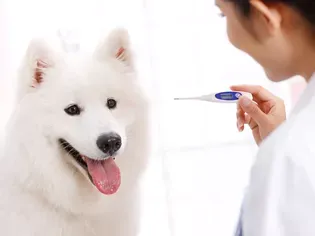How to Take Your Puppy's Temperature
Updated on 05/26/24

Taking Your Puppy's Temperature: A Comprehensive Guide to Ensure Your Furry Friend's Well-being
As a responsible puppy owner, knowing how to take your puppy's temperature is crucial for monitoring their health and well-being. An accurate temperature reading can provide valuable insights into their overall condition and help you determine if veterinary attention is necessary. This comprehensive guide will equip you with the knowledge and step-by-step instructions to confidently and effectively take your puppy's temperature.
Understanding Normal and Abnormal Temperatures
The normal temperature range for puppies varies slightly depending on their age and breed. Generally, puppies between 8 and 16 weeks old have a slightly higher temperature than adult dogs, ranging from 101.0°F (38.3°C) to 102.5°F (39.2°C). Adult dogs typically have a normal temperature between 100.5°F (38.0°C) and 102.5°F (39.2°C).
Deviations from these normal ranges may indicate an underlying health issue. Temperatures below 100°F (37.8°C) are considered hypothermia, a potentially life-threatening condition that requires immediate veterinary attention. Temperatures above 104°F (40.0°C) indicate hyperthermia, which can also be dangerous and should be treated promptly.
Materials You'll Need
* Digital rectal thermometer: Specifically designed for use on animals.
* Lubricant: Petroleum jelly or KY jelly to lubricate the thermometer.
* Towel or washcloth: To clean the thermometer.
* Treats: To reward your puppy for cooperation.
Step-by-Step Instructions
1. Prepare the Thermometer: Apply a small amount of lubricant to the tip of the thermometer. This will make it easier to insert and reduce discomfort for your puppy.
2. Position Your Puppy: Gently restrain your puppy in a standing or sitting position. Make sure they are comfortable and secure.
3. Insert the Thermometer: Holding the thermometer firmly, gently insert the lubricated tip into your puppy's rectum. Insert the thermometer about 1-2 inches for puppies under 12 weeks old and 2-3 inches for older puppies.
4. Hold and Read: Hold the thermometer in place for 1-2 minutes, or until the digital display stabilizes. Once the temperature is displayed, gently remove the thermometer.
5. Clean and Reward: Wipe the thermometer clean with a towel or washcloth. Reward your puppy with treats and praise for their cooperation.
Additional Tips
* Be Gentle: Always insert the thermometer slowly and gently to avoid injury or discomfort to your puppy.
* Use a Thermometer Designed for Animals: Human thermometers may not be accurate or safe to use on puppies.
* Take Multiple Readings: If you are concerned about your puppy's temperature, take multiple readings over a period of time. This will help you determine if the temperature is consistently abnormal.
* Monitor for Other Symptoms: In addition to taking your puppy's temperature, be aware of other signs of illness, such as lethargy, vomiting, diarrhea, or changes in appetite.
* Seek Veterinary Attention: If your puppy's temperature is consistently outside the normal range or if you notice any other signs of illness, contact your veterinarian immediately.
Example: Hypothermia
Hypothermia occurs when your puppy's body temperature drops below 100°F (37.8°C). Causes of hypothermia can include prolonged exposure to cold temperatures, immersion in cold water, or underlying medical conditions. Symptoms of hypothermia include shivering, lethargy, confusion, and pale gums. If you suspect your puppy is experiencing hypothermia, take their temperature immediately and seek veterinary attention.
Example: Hyperthermia
Hyperthermia occurs when your puppy's body temperature rises above 104°F (40.0°C). Causes of hyperthermia can include heat stroke, prolonged exposure to high temperatures, or underlying medical conditions. Symptoms of hyperthermia include panting, rapid breathing, drooling, and bright red gums. If you suspect your puppy is experiencing hyperthermia, take their temperature immediately and contact your veterinarian.
Conclusion
Taking your puppy's temperature is a crucial skill for every responsible owner. By following the steps outlined in this guide, you can confidently and effectively monitor your puppy's health and well-being. Remember, any deviation from the normal temperature range or additional symptoms of illness should prompt immediate veterinary attention. With the knowledge provided in this guide, you can ensure your furry friend's health and happiness for years to come.
Explore More Pets

Basic Training
Puppy and Baby Introductions

Working Dog Breeds
All About Search and Rescue Dogs

Dog Treatments
Puppy Vaginitis: Signs, Causes and Treatment

Dog Adoption
After More Than 1,200 Days in the Shelter, Coco Goes Home

Basic Training
How to Train Your Puppy to Go on Potty Pads

Hybrid Dog Breeds
The Difference Between a Mutt, Mixed Breed, or Designer Dog?

Dog Treatments
Nail Problems in Dogs

Puppies
7 Reasons Why Two Dogs Are Better Than One
